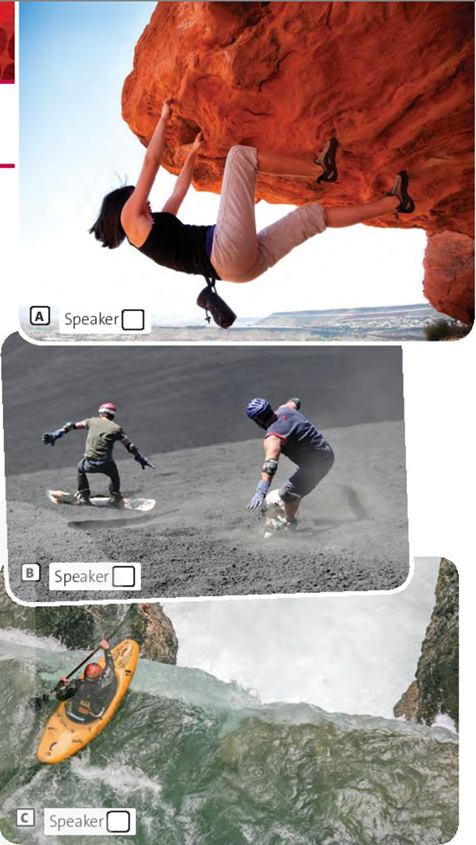Listen again. Are these sentences true (T) or false (F)? To help you, listen for synonyms or antonyms of the underlined words. (Lắng nghe một lần nữa. Những câu này đúng (T) hay sai (F)? Để giúp bạn, hãy nghe từ đồng nghĩa hoặc trái nghĩa của những từ được gạch chân.)


 Giải bởi Vietjack
Giải bởi Vietjack
F
Cô ấy thường nghĩ về những rủi ro khi tham gia môn thể thao của mình.
Gói VIP thi online tại VietJack (chỉ 400k/1 năm học), luyện tập gần 1 triệu câu hỏi có đáp án chi tiết
Read the text about BASE jumping and choose the correct answers (a-c) to complete gaps 1-5 (Đọc văn bản về nhảy BASE và chọn câu trả lời đúng (a-c) để hoàn thành khoảng trống 1-5)
BASE jumping is an extreme sport. It is (1) to skydiving, but there are important differences. Firstly, the jumps are much lower - usually no more than six hundred metres. And secondly, there is no aircraft. (2), participants jump from some kind of bridge, building or cliff. The first BASE jump took (3) in 1912 in New York, when Frederick Law jumped from the Statue of Liberty. In the 1960s and 70s, the sport became more popular, partly (4) to filmmaker Carl Boenish. He made documentaries about BASE jumping and also (5) of the name. He died in 1984 while he was jumping in Norway. BASE jumping is a thrilling experience, but it is very risky too.

Listen to three other people talking about the extreme sports in the photos above. Match speakers 1-3 with photos A-C. (Hãy lắng nghe ba người khác nói về các môn thể thao mạo hiểm trong các bức ảnh trên. Ghép loa 1-3 với ảnh A-C.)

Read the Listening Strategy. Then listen to Alex talking about wingsuit flying. Write the words he uses instead of the underlined words. (Đọc Chiến lược Nghe. Sau đó, hãy nghe Alex nói về bộ cánh bay. Viết những từ anh ấy sử dụng thay vì những từ được gạch chân.)
He spent a long time trying to find the right sport.
Listen again. Are these sentences true (T) or false (F)? To help you, listen for synonyms or antonyms of the underlined words. (Lắng nghe một lần nữa. Những câu này đúng (T) hay sai (F)? Để giúp bạn, hãy nghe từ đồng nghĩa hoặc trái nghĩa của những từ được gạch chân.)

Read the Listening Strategy. Then listen to Alex talking about wingsuit flying. Write the words he uses instead of the underlined words. (Đọc Chiến lược Nghe. Sau đó, hãy nghe Alex nói về bộ cánh bay. Viết những từ anh ấy sử dụng thay vì những từ được gạch chân.)
He thinks wingsuit flying is a great feeling.
Listen again. Are these sentences true (T) or false (F)? To help you, listen for synonyms or antonyms of the underlined words. (Lắng nghe một lần nữa. Những câu này đúng (T) hay sai (F)? Để giúp bạn, hãy nghe từ đồng nghĩa hoặc trái nghĩa của những từ được gạch chân.)

Listen again. Are these sentences true (T) or false (F)? To help you, listen for synonyms or antonyms of the underlined words. (Lắng nghe một lần nữa. Những câu này đúng (T) hay sai (F)? Để giúp bạn, hãy nghe từ đồng nghĩa hoặc trái nghĩa của những từ được gạch chân.)

Read the Listening Strategy. Then listen to Alex talking about wingsuit flying. Write the words he uses instead of the underlined words. (Đọc Chiến lược Nghe. Sau đó, hãy nghe Alex nói về bộ cánh bay. Viết những từ anh ấy sử dụng thay vì những từ được gạch chân.)
He disliked team games when he was a teenager.
Listen again. Are these sentences true (T) or false (F)? To help you, listen for synonyms or antonyms of the underlined words. (Lắng nghe một lần nữa. Những câu này đúng (T) hay sai (F)? Để giúp bạn, hãy nghe từ đồng nghĩa hoặc trái nghĩa của những từ được gạch chân.)


Read the Listening Strategy. Then listen to Alex talking about wingsuit flying. Write the words he uses instead of the underlined words. (Đọc Chiến lược Nghe. Sau đó, hãy nghe Alex nói về bộ cánh bay. Viết những từ anh ấy sử dụng thay vì những từ được gạch chân.)
Unfortunately, it is expensive.
Listen again. Are these sentences true (T) or false (F)? To help you, listen for synonyms or antonyms of the underlined words. (Lắng nghe một lần nữa. Những câu này đúng (T) hay sai (F)? Để giúp bạn, hãy nghe từ đồng nghĩa hoặc trái nghĩa của những từ được gạch chân.)
